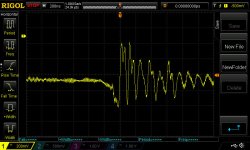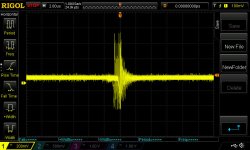Soldered a link straight across one diode, No difference at all to previous 'screw driver short'.
Pulled the clamp on the dud channel.
q18-21 2sa1302 as they should be.
q12-15 2sc3281 again correct.
power supply.
q50-53 q69-72 irfp084n - circuit claims 70n06, but pdf I have indicates its an engineering diagram, not for production use.
So that all looks ok to me.
Pulled the clamp on the dud channel.
q18-21 2sa1302 as they should be.
q12-15 2sc3281 again correct.
power supply.
q50-53 q69-72 irfp084n - circuit claims 70n06, but pdf I have indicates its an engineering diagram, not for production use.
So that all looks ok to me.
Do you see any sort of oscillation on the output transistors for the channel drawing excessive current?
Pin 6 does the exact same.
And I've just noticed it looks like that 5534 has been replaced on the bad channel.
marginally different package to other side, fresh solder, same part number etc.
checking against the good channel, signals and voltages are the same from side to side.
And I've just noticed it looks like that 5534 has been replaced on the bad channel.
marginally different package to other side, fresh solder, same part number etc.
checking against the good channel, signals and voltages are the same from side to side.
The reason that I'd remove it if I had this problem is to see if the problem is due to a biasing problem or the high frequency noise. It will also allow you to check the signal feeding the op-amp and the supplies for the op-amp (assuming that the current draw is reduced without the op-amp).
5534 pulled.
pin 6 on the board looks the same as it ever did.
current draw is still there.
It does take longer, maybe 3 or 4 times longer, but coil still whines, and still draws full current (which im still force limiting to 4 amps)
pin 6 on the board looks the same as it ever did.
current draw is still there.
It does take longer, maybe 3 or 4 times longer, but coil still whines, and still draws full current (which im still force limiting to 4 amps)
I know this guy who has the exact same problem as you. You might want to contact him to see how he fixed it. He also is really good with fixing squeaky noises in cars.....
I know this guy who has the exact same problem as you. You might want to contact him to see how he fixed it. He also is really good with fixing squeaky noises in cars.....
yeah, ok, we'll all find out together i guess 😛
I know mr deep thought....
Cheeky bugger 😉
That means that a problem outside of the audio section may be causing your problem and that problem may be causing additional problems when the audio circuit is active.
Mmmmmmmmmm.
So looks like a cluster..... of an issue.
No wonder the previous tech was unable to fix it.
By the sounds of it even the mighty Mr Babin has reached his limits.
And yes, I know, if it was in front of you on your bench it could be a different story.
Trying to diagnose or 'repair' remotely is always a challenge.
So looks like a cluster..... of an issue.
No wonder the previous tech was unable to fix it.
By the sounds of it even the mighty Mr Babin has reached his limits.
And yes, I know, if it was in front of you on your bench it could be a different story.
Trying to diagnose or 'repair' remotely is always a challenge.
Mmmmmmmmmm.
So looks like a cluster..... of an issue.
No wonder the previous tech was unable to fix it.
.
When things get desperate I usually pull all the semiconductors and test the resistors and capacitors in circuit.
Then I check all the semi's with a meter and a transistor checker.
I once got caught out with a transistor that DMM'ed ok but when I did a transistor hfe check it had a gain of 1 !
yes..
Theres always the 'bare earth' approach.
Some devices dont lend themselves to this without considerable time and effort.
If it was my amp, id consider going this route.
But it only takes one part that behalves in a way i cant measure to lay waste to hundreds off dollars in parts and countless hours.
realistically unless it had strong sentimental or emotional ties to me, id prob wright it off and move on to a replacement.
Not being mine stretches that 'freindship' 😀
Theres always the 'bare earth' approach.
Some devices dont lend themselves to this without considerable time and effort.
If it was my amp, id consider going this route.
But it only takes one part that behalves in a way i cant measure to lay waste to hundreds off dollars in parts and countless hours.
realistically unless it had strong sentimental or emotional ties to me, id prob wright it off and move on to a replacement.
Not being mine stretches that 'freindship' 😀
Some amps require that you keep eliminating various parts until you find the actual fault or faults. If the current is no longer flowing through the output transistors, the fault would seem to be in the power supply.
does the whining toroid give any clues as to what to look at next ?
guess i should look at the 494 wave forms.
I remember reading about the rare but possible issue of the toroids themselves becoming faulty.
guess i should look at the 494 wave forms.
I remember reading about the rare but possible issue of the toroids themselves becoming faulty.
Last edited:
- Status
- Not open for further replies.
- Home
- General Interest
- Car Audio
- Orion NT200 fault finding help

